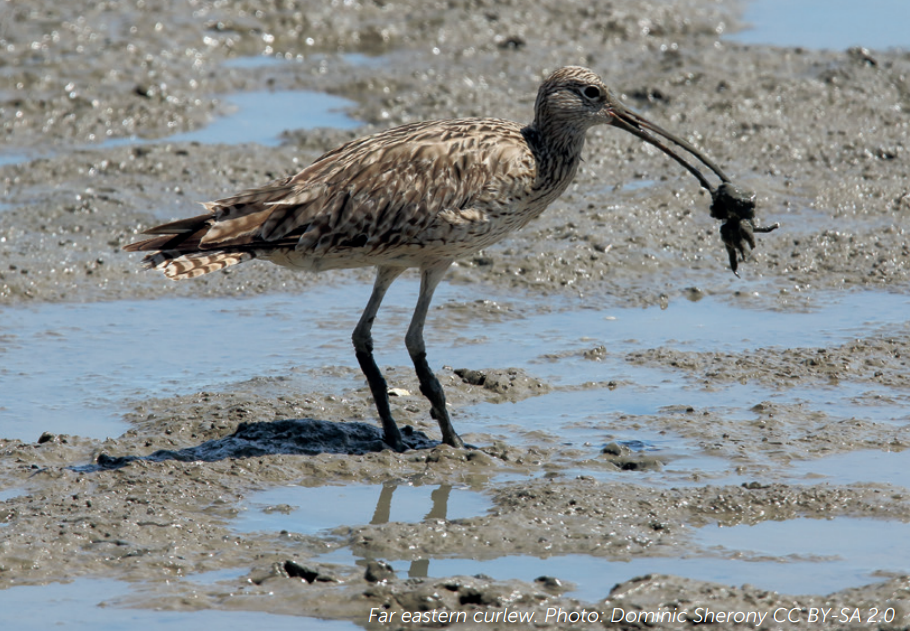The Far Eastern Curlew (Numenius madagascariensis) is one of the largest migratory shorebirds in the world. It has experienced one of the most acute declines of any Australian shorebird species: a 5.8 per cent annual rate of decline. If this trend persists, the global population will fall to 10 per cent of its 1993 abundance by 2035. It is listed as Endangered on the IUCN Red List and Critically Endangered under Australia’s EPBC Act.
It is endemic to the East Asian-Australasian Flyway and is heavily impacted by mudflat loss and degradation in north-east Asia. Loss of habitat in this region can make birds more sensitive to impacts in other regions of the flyway, such as Australia.
Around three quarters of the population is estimated to spend the non-breeding season in Australia, where it is impacted by coastal development and disturbance. Very little is known about the exact habitat requirements of Far Eastern Curlew at non-breeding sites, making it extremely difficult to provide appropriate guidance on development proposals affecting Far Eastern Curlew habitat.
Coastal development can negatively affect Far Eastern Curlew populations. However, they are also known to use some artificial habitats for roosting, sometimes incorporating developed areas into local movements. This behaviour provides opportunities and obligations to consider and manage artificial sites as part of local conservation efforts. This project will analyse Far Eastern Curlew feeding and roosting habitat and the relationship between the two in order to develop evidence based strategic guidelines for Far Eastern Curlew conservation. The guidelines will give certainty to policy makers, conservation planners, developers and regulators about habitat requirements and offsets.
A large number of Far Eastern Curlew and other migratory shorebirds roost on land belonging to Darwin Port, where they feed on surrounding mudflats. The numbers of Far Eastern Curlew roosting at the port, where the birds are protected from disturbance, has increased substantially. The maximum count recorded at the port is 264 birds which is about 0.85% of the total flyway population. Darwin Port are planning to expand operations in future, and seek to understand how to achieve this without negatively impacting the quality of habitats available to migratory birds visiting the Port lands.
The project will be undertaken in close cooperation with Darwin Port who are also providing financial support for the research. The project will assess the overall availability of suitable habitats, the impacts of developments within Darwin Harbour and the port and the ways in which these impacts could be mitigated.
FACTSHEETS:
Caring for curlews and the coastline – http://www.nespthreatenedspecies.edu.au/5.1.1%20Curlew%20factsheet_V3.pdf
Strategic planning for the Far Eastern Curlew – http://www.nespthreatenedspecies.edu.au/5.1.1%20Curlew%20Project%20Summary%20Factsheet_Digital.pdf
The importance of artificial roosts for migratory shorebirds – http://www.nespthreatenedspecies.edu.au/publications-tools/factsheet-the-importance-of-artificial-roosts-for-migratory-shorebirds
Progress report 1 – http://www.nespthreatenedspecies.edu.au/_images/News/5.1.1%20Far%20Eastern%20Curlew%20Progress%20Report_V2.pdf
Progress report 2 – http://www.nespthreatenedspecies.edu.au/5.1.1%20Far%20Eastern%20Curlew%20Progress%20Report%202_V3.pdf
Progress report 3 – http://www.nespthreatenedspecies.edu.au/5.1.1%20Far%20Eastern%20Curlew%20Progress%20Report%202_V3.pdf





